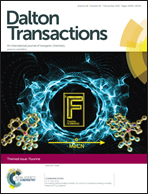Stoichiometric and catalytic C–F bond activation by the trans-dihydride NHC complex [Ru(IEt2Me2)2(PPh3)2H2] (IEt2Me2 = 1,3-diethyl-4,5-dimethylimidazol-2-ylidene)†
Abstract
The room temperature reaction of C6F6 or C6F5H with [Ru(IEt2Me2)2(PPh3)2H2] (1; IEt2Me2 = 1,3-diethyl-4,5-dimethylimidazol-2-ylidene) generated a mixture of the trans-hydride fluoride complex [Ru(IEt2Me2)2(PPh3)2HF] (2) and the bis-carbene pentafluorophenyl species [Ru(IEt2Me2)2(PPh3)(C6F5)H] (3). The formation of 3 resulted from C–H activation of C6F5H (formed from C6F6via stoichiometric hydrodefluorination), a process which could be reversed by working under 4 atm H2. Upon heating 1 with C6F5H, the bis-phosphine derivative [Ru(IEt2Me2)(PPh3)2(C6F5)H] (4) was isolated. A more efficient route to 2 involved treatment of 1 with 0.33 eq. of TREAT-HF (Et3N·3HF); excess reagent gave instead the [H2F3]− salt (5) of the known cation [Ru(IEt2Me2)2(PPh3)2H]+. Under catalytic conditions, 1 proved to be an active precursor for hydrodefluorination, converting C6F6 to a mixture of tri, di and monofluorobenzenes (TON = 37) at 363 K with 10 mol% 1 and Et3SiH as the reductant.
![Graphical abstract: Stoichiometric and catalytic C–F bond activation by the trans-dihydride NHC complex [Ru(IEt2Me2)2(PPh3)2H2] (IEt2Me2 = 1,3-diethyl-4,5-dimethylimidazol-2-ylidene)](/en/Image/Get?imageInfo.ImageType=GA&imageInfo.ImageIdentifier.ManuscriptID=C5DT01996F&imageInfo.ImageIdentifier.Year=2015)
- This article is part of the themed collection: Fluorine

 Please wait while we load your content...
Please wait while we load your content...